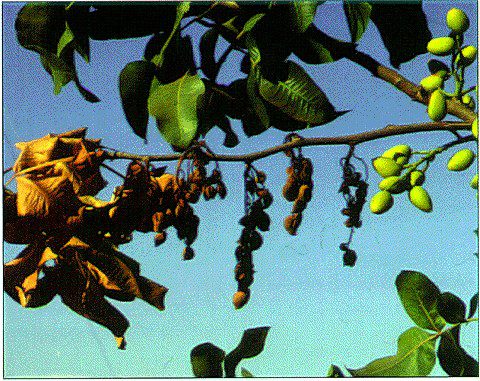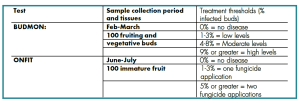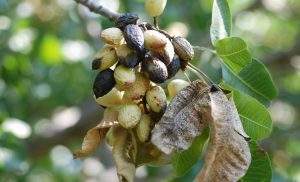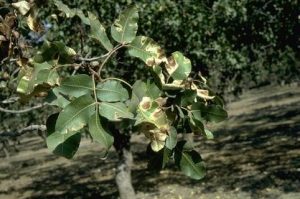
Botryosphaeria panicle and shoot blight (Botryosphaeria blight), caused by a group of Botryosphaeria species, can be devastating to pistachio orchards. When it first appeared, poor understanding of the disease life cycle, how spores spread and the lack of registered fungicides could result in yield losses of 40% to 100%. Fortunately, decades of research by Themis Michailides and his associates have given us a much better understanding of the disease and the causal pathogen, and there are now a wide range of effective fungicides registered for controlling this disease.
The fungi causing this disease can be found on several native species in California as well as almonds and walnuts. It can presumably be carried into orchards on wildlife and insect pests or via airborne spores and may be how the fungi initially get into an orchard; however, for an existing outbreak, the majority of infection sources are within an orchard. This is because infected tissues that are left in the orchard produce pycnidia (the fungal structures that produce spores) and can do so for several years after death. Cankers on branches, fruit, leaves and retained rachises can all be sources of inoculum. Understanding this is critical to control of this disease, which will be discussed at the end of this article.
Spores produced by pycnidia are dispersed by water landing on infected plant parts and then carrying it to new tissues to infect. Botryosphaeria fungi require temperatures above 50 degrees F to infect plant tissues, though its growth is favored at temperatures between 80 and 90 degrees F. Just a few hours of rain or sprinkler irrigation can result in spore release, though the length of time needed for these spores to infect tissue is closer to 9 to 12 hours.

Botryosphaeria blight requires some sort of natural opening in the plant to invade. This can be stomata, lenticels, scars of abscised buds and plant bug damage as well as bird damage, and infections can happen at any time of the year. Botryosphaeria spores can even colonize dead wood. Curiously enough, pruning wounds are not considered to be very vulnerable to infection.
Pistachio buds that are infected in the fall may be killed outright and never emerge. If they survive infection, they will emerge the following spring and develop disease symptoms once temperatures increase. A dark lesion will form at the base of the young shoot and the shoot will wither and die (Figure 1). If the infected bud was a reproductive bud, the same will occur at the base of the rachis. These will remain in the tree until after harvest and are easy to spot.
Plant tissues that are infected in fall or spring rain events will not show evidence of infection right away because temperatures are typically cool and fungal growth is minimal at the time of infection. However, once temperatures increase in late spring/early summer, the fungus will grow rapidly and begin killing tissues. An infection on green tissue will start as a small, dark lesion the size of a pin (Figure 2). As the disease worsens, it will enlarge and may move into the rachis and kill the cluster. If the infection occurs on a petiole, it will kill the entire leaf, though infections on the leaflet do not do so, likely because the leaflet falls off the petiole.

As the disease develops, pycnidia will be produced in August through October and the appearance of the infection will change. Infected fruit will shift from black (Figure 3) to a silvery gray, while non-infected fruit on a blighted rachis will look tan. Tan, necrotic tissue will form around lesions on leaves (Figure 4). Leaf infections of Botryosphaeria panicle and shoot blight can be similar in appearance to Alternaria. An easy way to tell is to rub your finger over the black lesions on leaves; if spores transfer to your fingers, the infection is Alternaria, and if your fingers are clean, it is Botryosphaeria. Both infections can occur on the same leaf. The pycnidia that develop in the summer can cause secondary infections.

Blighted rachises, mummies and branches will remain on the trees and can produce spores for years, though fruit will not remain on the tree for that long. Because of this, it is important to remove infected tissues as soon as possible to remove inoculum sources.

Critical Infection Times
One of the earliest tactics to control Botryosphaeria panicle and shoot blight was through modifying irrigation practices. In the early days of pistachio production in the Sacramento Valley, full-coverage sprinklers with a high trajectory angle were used for irrigation, and lower branches, leaves and fruit would be wetted by the sprinklers. This would create the necessary wetness for infections and also wash spores to uninfected plant tissues. Research clearly showed that reducing the trajectory angle of the sprinklers to 12 degrees and keeping irrigation durations short would reduce disease by removing the water required for spore release and infection.
The vast majority of pistachio orchards are now on microirrigation, but Botryosphaeria panicle and shoot blight can still be an issue when springs are wet. In these orchards, springtime rain is required for infections to occur. Not just any rain, however: rain over a long enough period of time for spores to germinate and infect tissues (spores germinate in 1.5 hours.) Short bursts of rain followed by sunny weather would be a low risk for Botryosphaeria infection, whereas longer periods of rain, or rain that occurs in the late afternoon or early evening when leaves cannot dry out afterward, are moderate- to high-risk infection events. High levels of humidity will prolong the length of time leaves remain wet after a rain event.
It is not required for spores to land on healthy tissues for infection to occur; they can colonize dead wood, and can also land on healthy leaf axils where a bud is developing. When emerging buds grow, they pick up these spores and become infected.
UC Davis’ Themis Michailides has developed a leaf wetness model to help decision making; it is dependent on temperatures favorable for infection (50 degrees F or above) and the length of time leaves remain wet. The higher the temperature or the longer the period of leaf wetness, the higher the risk. Luckily, many fungicides are still effective if they are applied several days after an infection event. While fungicides are always best applied before an infection event, this allows growers more flexibility if it is unclear if a rain event will result in a high risk for infection.
Assessing Infection Risk
Aside from rain events, there are two tests that can help a grower determine their Botryosphaeria risk; these are most useful for orchards with low to no history of Botryosphaeria infection. They are the BUDMON and ONFIT tests. Both require sampling plant tissues and sending them to a pathology laboratory. The BUDMON is determined by collecting buds in February and March and ONFIT is from immature fruit collected in June and early July. Table 1 (see page 64) shows results with suggested management decisions.
Of course, growers who have orchards with a history of severe Botryosphaeria infections should assume they are at a high risk for future infections and should pursue an aggressive management campaign to reduce the levels of inoculum in their orchards, discussed below, though BUDMON and ONFIT tests can be a useful method to determine whether control methods are working.
Control
Growers without a history of bot infections that have BUDMON/ONFIT tests indicating no risk for infection do not need to do anything other than continue to monitor for the presence of the disease. Orchards on the west side of the southern San Joaquin Valley are at low risk for this disease, and there is likely little need for any management aside from occasional monitoring. If an orchard is near a natural area or another orchard with severe Botryosphaeria infections, it may be advisable to apply fungicides before high-risk rain events (long rainy periods during warm weather.)
For orchards with a history of the disease and/or BUDMON tests that indicate sprays need to occur, spray before rain events that indicate moderate to high risk of infection with the leaf wetness model. Continue to spray before additional moderate to severe rain events if the product applied does not have residuals that last until the next rain event. Be careful of your fungicide selection; some are not appropriate for orchards with a severe history of infection. Rotate modes of action if you need multiple sprays. While there are no documented cases of fungicide resistance in the Botryosphaeria species found in California pistachio orchards, this pathogen has been shown to develop resistance in lab tests and other areas of the U.S., so it is possible for resistance to evolve.
If an orchard has a history of severe disease, sprays will not be enough. Plan for an aggressive pruning program to remove branches that have been blighted by Botryosphaeria; this should be done in the summer when blighted shoots are obvious, and this also reduces the chances for secondary infections. In orchards with severe infections, an additional pruning should be conducted in December/January when it is typically too cold for spores to germinate. While this is costly, dead wood and retained rachises can be a source of spores for years. The wood must be burned; spores can survive for more than a year if shredded and tilled into the soil. Plan for a spray at bloom and continue for as long as rain occurs. Shake mummies in the winter as they can also be a source of spores.
Work done almost 20 years ago led by Brent Holtz showed that a combined approach of pruning and fungicide sprays in orchards with moderate to severe Botryosphaeria infections reduced disease severity and improved nut quality. The infestation was severe, requiring an average of 150 pruning cuts a tree to remove blighted shoots and clusters.
The cost of pruning and fungicide applications were about $200 an acre each but yielded an increased payout of $600 an acre at a price of $1 per pound compared to doing nothing. Using a fungicide with or without pruning reduced disease levels, but adding pruning to a fungicide treatment increased the split inshell from 42.1% to 56.5%, decreased shelling stock from 16.9% to 8.4% and decreased dark stained shells from 9.4% to 4.2%. The costs of hand pruning have only gone up since then and the economics of hand pruning, and whether hedging is an effective way of reducing blighted wood should be revisited. Regardless, avoiding infestations so severe that pruning is required would be the best route.
Water management is also critical for reducing infections. Water-stressed trees have been shown to be more predisposed to infection; however, orchards with high humidity can increase infection risk and disease severity. In general, drip irrigation has been shown to be the best irrigation system for minimizing infection risk. Additionally, trees that have adequate potassium levels may have less severe infections.















